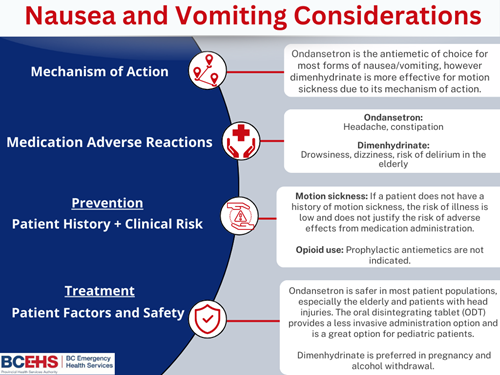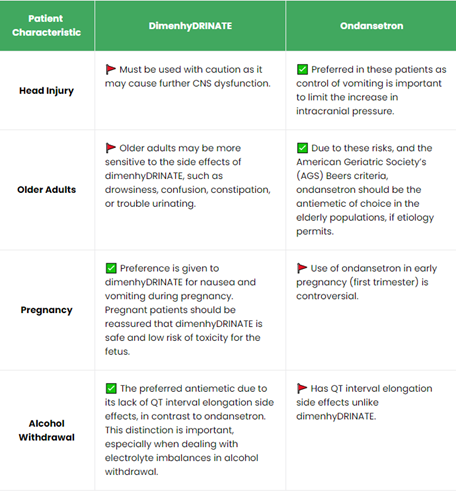Confirmation
Download PDF
Open All
E07: Nausea and Vomiting
Updated:
Reviewed:
Introduction
Nausea is the unpleasant, disabling, and painless urge to vomit. It can exist independently or be accompanied by vomiting. The potential causes for nausea and vomiting are extensive; nausea and vomiting are not considered diseases in and of themselves but rather symptoms of other conditions. In caring for individuals with nausea and/or vomiting, paramedics and EMRs/FRs should work towards two goals: identification of the underlying cause to determine appropriate treatment and the management of symptoms to improve patient comfort.
Essentials
- An attempt at identifying acute etiologies for nausea and vomiting must be made.
- Provide therapies to alleviate symptoms.
- Facilitate appropriate conveyance.
Additional Treatment Information
- Intramuscular (IM) dimenhydrinate is a safe and effective anti-emetic. It should only be used for nausea that is actually present and not be considered for prophylaxis.
- Ondansetron is an effective anti-emetic for nausea and vomiting secondary to radiation, chemotherapy, surgery, and gastroenteritis. It provides little relief from motion sickness.
- Dimenhydrinate must be used with caution for head injuries as it may cause further CNS dysfunction. Ondansetron is preferred in these patients as control of vomiting is important to limit the increase in intracranial pressure.
- Look for the following signs of dehydration: postural perfusion changes including tachycardia; hypotension or dizziness; decreased sweating and urination; poor skin turgor; dry mouth/tongue; fatigue; altered consciousness; and evidence of poor fluid intake compared to fluid loss. Dehydrated patients are candidates for volume replacement.
- Older adults may be more sensitive to the side effects of dimenhyDRINATE, especially drowsiness, confusion, constipation, or trouble urinating. Drowsiness and confusion can increase the risk of falling. Reduce the dosage administered to elderly or frail patients.
General Information
- A complete physical and neurological assessment should be completed for all patients. Acute etiologies may include but are not limited to:
- Myocardial infarction
- Cerebrovascular accident
- Sepsis
- Gastrointestinal bleeding
- Meningitis
- Ischemic bowel
- Diabetic ketoacidosis
- Overdose or drug toxicity (consider adverse drug reactions)
- Carbon monoxide poisoning
- Common causes of nausea and vomiting include:
- Vertigo: One of the most common causes of out-of-hospital nausea/vomiting, this is the perceived sensation of motion often described as spinning or whirling. Sweating, pallor, nausea, vomiting, and balance disturbances often accompany vertigo. Vertigo is caused by many different factors including:
- Impaired visual input, inner ear function, or peripheral sensory input
- CNS impairments (e.g., alcohol, prescription drugs)
- Disease (e.g., Meniere’s disease)
- Migraines: These headaches can last from minutes to days and are characterized by intense throbbing pain, photosensitivity, nausea and vomiting, and sweating. Patients may be prescribed metoclopramide as it treats both the pain and nausea associated with suspected migraines.
- Opioid-induced: Due to the low incidence of opioid-induced nausea, the lack of efficacy of prophylactic therapy, and the possibility of additional side effects, opioids should not be accompanied by an antiemetic agent. Antiemetic therapy is only indicated if the patient develops nausea or vomiting after opioid use.
- Alcohol withdrawal: Patients experiencing alcohol withdrawal are at higher risk of developing electrolyte abnormalities which can affect the QT interval. Dimenhydrinate is the antiemetic of choice in these cases as it does not cause QT interval elongation.
- Upper gastrointestinal bleeding: Blood in the stomach is often a cause of extreme nausea. Metoclopramide can be useful in these cases as it improves gastric emptying in addition to treating nausea.
- Pregnancy: Nausea can be a common issue during pregnancy, especially in the first trimester and in the morning. Dimenhydrinate is considered to be the first-line medication for nausea and vomiting that is safe and effective during pregnancy. Women should be reassured as to dimenhydrinate’s safety and low risk of toxicity for the fetus.
- Vertigo: One of the most common causes of out-of-hospital nausea/vomiting, this is the perceived sensation of motion often described as spinning or whirling. Sweating, pallor, nausea, vomiting, and balance disturbances often accompany vertigo. Vertigo is caused by many different factors including:
Interventions
First Responder (FR) Interventions
- Keep the patient at rest in a position of comfort
- Maintain patient in position of comfort consistent with the need to protect the patient’s airway
Emergency Medical Responder (EMR) & All License Levels Interventions
- Convey patient in position of comfort consistent with the need to protect the patient’s airway
Primary Care Paramedic (PCP) Interventions
- Consider vascular access
- Consider ondansetron
- Consider dimenhyDRINATE
- ⚠️ PCP and ACP: requires completion of scope expansion education or other appropriate BCEHS-specific education
- Treat hypotension from volume loss:
- Normal saline 500 mL bolus to a maximum of 2 L
- Reassess after every bolus; target systolic blood pressure of 90 mmHg
Critical Care Paramedic (CCP) Interventions
- Consider ondansetron
- Consider Metoclopramide
- Consider prochlorperazine
Algorithm



Evidence Based Practice
References
Practice Updates
- 2023-09-29: added ondansetron to PCP interventions